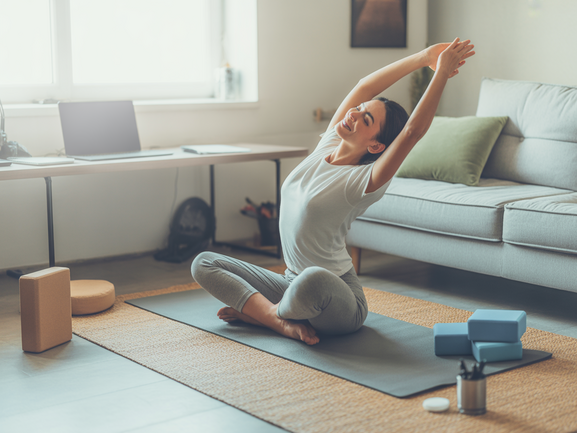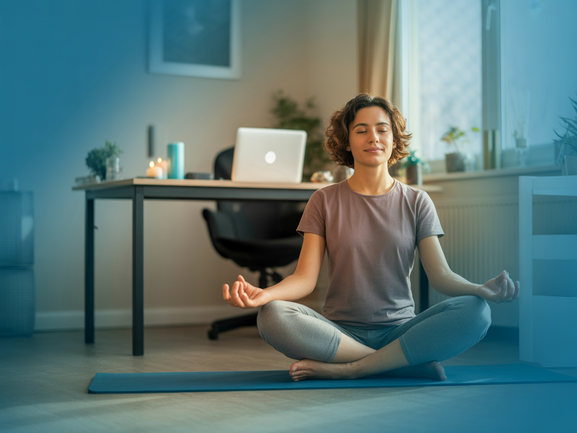Yoga for Home Office Workers: The Ultimate Guide to Boost Wellness in 2025
Summary: This guide provides a deep dive into yoga for home office workers, offering everything from essential terms to practical routines. Discover how to combat the strains of remote work, improve posture, reduce stress, and increase productivity right from your desk.
Why Yoga for Home Office Workers is Essential for Your Well-being
Have you ever ended your workday with a stiff neck, an aching back, and a feeling of mental exhaustion? If you’re a remote worker, the answer is likely a resounding yes. The shift to home offices has brought flexibility, but it has also blurred the lines between work and rest, often leading to a sedentary lifestyle. Yoga for home office workers is a targeted practice designed to counteract these specific challenges.
This isn’t about mastering complex poses; it’s about integrating small, powerful moments of wellness into your daily routine. By understanding a few core principles of yoga, you can transform your workspace from a source of strain into a sanctuary of health. This guide will demystify the essential vocabulary and provide actionable steps to build a healthier, more balanced remote work life. For a seamless start, the Vitalizen App | Yoga + Meditation is your perfect companion.
The Science of Sedentary Work: What Happens to Your Body?
In 2025, with millions settled into permanent remote roles, understanding the physical toll of sitting is more critical than ever. Prolonged sitting isn’t just about discomfort; it triggers a cascade of negative physiological effects. Desk yoga directly addresses these issues, making it a vital tool for modern professionals.
According to a study published on the National Institutes of Health (NIH) website, prolonged sitting significantly increases the risk of musculoskeletal disorders. A 2025 report highlights that over 60% of office workers experience chronic back pain annually.
Here’s a breakdown of what happens when you sit for too long and how yoga can help:
- Postural Slump: Hunching over a keyboard weakens back muscles and tightens the chest, leading to the classic ‘desk slump.’ Yoga strengthens your core and opens your chest to correct this.
- Hip and Leg Stiffness: Your hip flexors shorten, and hamstrings tighten, reducing mobility and causing lower back pain. Poses like Downward-Facing Dog and Warrior I are excellent for releasing this tension.
- Reduced Circulation: Sitting for hours can slow blood flow, especially to your legs. Gentle movement and stretching boost circulation, delivering fresh oxygen to your muscles and brain.
- Mental Fatigue: A static body often leads to a sluggish mind. Mindful breathing (Pranayama) and short meditation breaks are proven to lower stress hormones and sharpen focus.
The Essential Glossary of Yoga for Home Office Workers
To truly embrace yoga, it helps to know the language. Think of this as your personal encyclopedia, tailored for the remote worker. We’ve organized the most crucial terms into categories that you can apply directly to your workday challenges.
Asanas (Poses): Your Physical Toolkit for Desk Discomfort
Asanas are the physical postures in yoga. For home office workers, they are your first line of defense against stiffness and pain. Here are some of the most effective ones you can do.
- Tadasana (Mountain Pose): The blueprint for all standing poses. It realigns your spine and resets your posture. How to do it: Stand with feet together, ground down through your soles, engage your legs, and lengthen your spine. It’s the perfect way to feel centered after hours of sitting.
- Marjaryasana-Bitilasana (Cat-Cow Pose): A dynamic flow that acts as a mini-massage for your spine. How to do it: On hands and knees (or even seated), inhale to arch your back (Cow) and exhale to round it (Cat). This is ideal for relieving back tension.
- Adho Mukha Svanasana (Downward-Facing Dog): A full-body stretch that targets hamstrings, shoulders, and the spine. It’s a powerful antidote to a sedentary day, boosting blood flow to the brain.
- Virabhadrasana I (Warrior I): A powerful pose that builds strength and opens the hips. Think of it as your power stance to build confidence before a crucial video call.
- Gomukhasana (Cow Face Pose) Arms: An intense shoulder opener that directly counters the effects of typing and hunching. How to do it: Reach one arm up and bend the elbow, letting the hand fall down your back. Reach the other arm behind your back to clasp the fingers.
Pranayama (Breathing Techniques): Your Secret Weapon Against Stress
Pranayama is the practice of breath control. It’s one of the fastest ways to manage your nervous system and shift your mental state.
- Ujjayi (Victorious Breath): A soft, audible breath made by gently constricting the back of the throat. It’s like a built-in white noise machine that calms the mind and helps you focus.
- Nadi Shodhana (Alternate Nostril Breathing): A powerful technique for balancing the brain’s hemispheres, promoting calm and clarity. It’s a mental decluttering tool for a scattered mind.
- Sama Vritti (Box Breathing): Inhale for a count of four, hold for four, exhale for four, and hold for four. This simple, rhythmic practice is incredibly effective at managing acute anxiety during a stressful workday.
Meditation and Mindfulness: Your Path to Unshakeable Focus
These practices train your mind to be more present and less reactive—an invaluable skill in a distraction-filled home office.
- Dhyana (Meditation): The art of sustained, focused attention. Even five minutes a day can drastically reduce mental fatigue and improve your ability to concentrate on complex tasks.
- Vipassana (Insight Meditation): The practice of observing your thoughts and feelings without judgment. It helps you detach from work stress, viewing challenges with a clearer, more objective perspective.
- Mantra: A word or sound repeated to aid concentration during meditation. It can be as simple as ‘focus’ or ‘calm’ to anchor your wandering mind.
How to Start a Desk Yoga Practice Today: A 5-Step Routine
Starting is simpler than you think. Consistency is more important than duration. Small, frequent breaks are more beneficial than one long, sporadic session. Here is a simple routine to get you started:
- Schedule It: Block two 10-minute ‘Wellness Breaks’ in your calendar—one mid-morning and one mid- afternoon. Treat them as non-negotiable appointments.
- Morning Spine Wake-Up (2 mins): Begin your day with five rounds of seated Marjaryasana-Bitilasana (Cat-Cow) to gently awaken your spine.
- Pre-Meeting Power-Up (1 min): Before an important meeting, stand in Tadasana (Mountain Pose) and take three deep Ujjayi breaths to center yourself.
- Lunch Break Mental Reset (5 mins): Use the Vitalizen App for a 5-minute guided meditation. This will help you detach from work and return with renewed focus.
- End-of-Day Decompression (2 mins): Finish your workday with a standing forward fold and a gentle Adho Mukha Svanasana (Downward-Facing Dog) to release the day’s tension.
For more tips and guided sessions, explore our company blog.
💡 Tip: Ready to build a consistent habit? Download our free Quick-Start Checklist to track your progress!
Quick Reference: Which Yoga Practice Do You Need Right Now?
Feeling overwhelmed by the options? Use this table to quickly identify which practice to turn to based on your immediate need. This is your cheat sheet for on-the-spot relief.
| Term | Category | Best For… |
|---|---|---|
| Asana | Poses | Relieving physical stiffness, aches, and improving posture. |
| Pranayama | Breathing | Instantly reducing stress, calming anxiety, and enhancing focus. |
| Dhyana | Meditation | Boosting mental clarity, improving concentration, and reducing mental fatigue. |
| Namaste | Gesture | Cultivating a sense of peace and respect to close your practice. |
Frequently Asked Questions (FAQ)
What is the most important yoga term for a beginner?
‘Asana’ (pose). Understanding that yoga is about finding stability and comfort in physical postures is the foundation. It’s the practice that directly combats the aches and pains of desk work.
Can I effectively practice yoga in my office chair?
Absolutely. Many effective yoga practices are chair-based. You can do seated Cat-Cow, gentle spinal twists, neck rolls, and shoulder shrugs. Combining these with mindful breathing (Pranayama) can significantly improve your well-being without leaving your desk.
How much does it cost to start yoga for home office workers?
It can be completely free. You don’t need special equipment to begin; your chair and a small amount of space are sufficient. While apps like Vitalizen or a yoga mat can enhance the experience, they are not necessary to start seeing benefits.
When is the best time to practice yoga during the workday?
The best time is any time you can be consistent. A short morning stretch to energize, a breathing exercise before a stressful task, and a brief meditation during lunch to reset are all highly effective strategies.
Where can I find reliable guided yoga sessions for my level?
For curated, level-appropriate sessions, an application like the Vitalizen App is an excellent resource. It offers routines specifically designed for different needs and skill levels, ensuring you practice safely and effectively. This removes the guesswork and helps you build a consistent habit.



